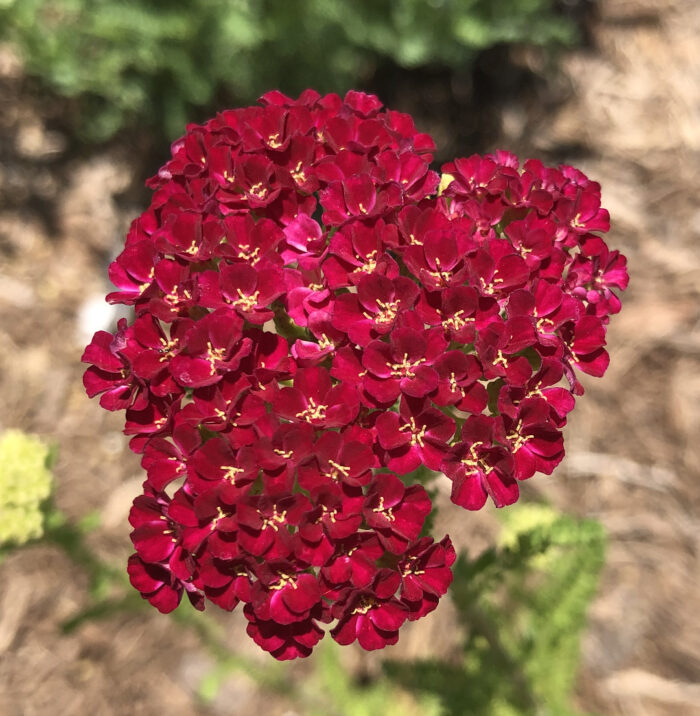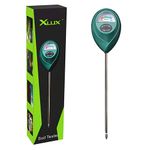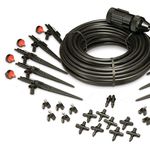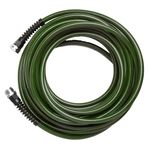
We’re visiting Alex’s garden today.
I am an IT project manager and avid fiber artist who lives in central Delaware. Gardening for me started in childhood with weed-pulling responsibilities in a Massachusetts suburban setting. I’ve personally landscaped and enhanced every house I’ve owned as an adult. Gardening provides a retreat and a calming place amidst the everyday chatter that life often delivers. Gardening is a relaxing activity that allows us to support our environment in a meaningful and rewarding way.
This subdivision property is a little over twenty years old, but I moved into this property two years ago. Other than some mature shrubbery directly in the front of the house entry porch, a 2-foot strip of basement-hiding plantings, and two mature trees in the back corner, the yard was a blank slate.
The goal was to support our environment by planting natives—food for the pollinators and a pit stop for the monarchs—while providing passive solar shading for the back of the house, which faces west. Also on the west side is a sunroom and a dining room with west-facing windows. Over the winter the idea was planned, and then early this spring the idea became a garden dubbed Dogwood Grove in honor of the three foundation dogwoods (Cornus florida, Zones 5–8), which will eventually provide shade from the west summer sun.
The bees love all the flowering plants, but especially the Monarda. The false river stream and large rock actually hide the water spout from the nearby house gutter that directs the rainwater into the yard. The list of plants includes Amsonia (Zones 5–8), Asclepias incarnata (swamp milkweed, Zones 3–6) for the monarchs, Baptisia (Zones 3–9), boltonia (Boltonia asteroides, Zones 3–10), Coreopsis (Zones 4–9), Dendranthema (hardy mum, Zones 5–9), various species of Echinacea (coneflower, Zones 5–9), gaura (Gaura lindheimeri, Zones 5–9), Iris germanica (Zones 3–10), Penstemon, creeping phlox (Phlox subulata, Zones 3–9), garden phlox (Phlox paniculata, Zones 3–8), yarrow (Achillea millefolium, Zones 3–9), and verbena (Verbena bonariensis, Zones 7–11 or as an annual). The colors last from spring through fall.
The plants are a mix of native and zone-friendly in our Zone 7a. We planted in groups of three or more in a white, purple, and red color scheme. We had one errant red-peach Echinacea labeled incorrectly! The last entrants to the grove will be spring hyacinth bulbs in the same color spectrum, to be planted later this fall.
 In the foreground is verbena, with white phlox behind—both favorites of butterflies and other pollinators. Other plants are still small and beginning to fill in.
In the foreground is verbena, with white phlox behind—both favorites of butterflies and other pollinators. Other plants are still small and beginning to fill in.
 An intensely red yarrow. These durable, native perennials are beautiful, dependable, and beloved by a wide range of pollinators.
An intensely red yarrow. These durable, native perennials are beautiful, dependable, and beloved by a wide range of pollinators.
 The young dogwood trees in the new garden bed will develop into the shade-providing dogwood grove. This garden will only improve as the perennials expand and fill the space.
The young dogwood trees in the new garden bed will develop into the shade-providing dogwood grove. This garden will only improve as the perennials expand and fill the space.
 A hardy mum with pink daisy flowers. Mum varieties vary widely in winter hardiness, but the best can survive winters in Zone 5 or even 4. They’ll have the best chance to overwinter in cold climates if they are planted in the spring so that they have time to get established before winter arrives.
A hardy mum with pink daisy flowers. Mum varieties vary widely in winter hardiness, but the best can survive winters in Zone 5 or even 4. They’ll have the best chance to overwinter in cold climates if they are planted in the spring so that they have time to get established before winter arrives.
 Double red echinaceas, with one mislabeled plant showing bicolored red-and-orange flowers.
Double red echinaceas, with one mislabeled plant showing bicolored red-and-orange flowers.
Have a garden you’d like to share?
Have photos to share? We’d love to see your garden, a particular collection of plants you love, or a wonderful garden you had the chance to visit!
To submit, send 5-10 photos to [email protected] along with some information about the plants in the pictures and where you took the photos. We’d love to hear where you are located, how long you’ve been gardening, successes you are proud of, failures you learned from, hopes for the future, favorite plants, or funny stories from your garden.
If you want to send photos in separate emails to the GPOD email box that is just fine.
Have a mobile phone? Tag your photos on Facebook, Instagram or Twitter with #FineGardening!
You don’t have to be a professional garden photographer – check out our garden photography tips!
Do you receive the GPOD by email yet? Sign up here.
Fine Gardening Recommended Products

XLUX Soil Moisture Meter

Rain Bird PATIOKIT Drip Irrigation Patio Watering Kit

Water Right PSH-100-MG-1PKRS 400 Series, 100-Foot, Olive Green

















Comments
I love your vision for Dogwood Grove, and love a garden with a name!
Hope you post again as your Dogwood Grove evolves and grows.
Your perennial beds are thriving and healthy and certainly adding plants to help out the pollinators.
Your verbena is doing great- so beautiful!
Well on your way to a very beautiful garden! That red yarrow is spectacular, and I love that you've planted with pollinators in mind. High five for your Dogwood Grove idea!
What a great start to your new garden. I hope the bees, butterflies and birds have moved in to join you. Looking forward to next seasons' photos!
Yeah, love the idea of a Dogwood grove. Very cool that you stuck with Cornus Florida as well.
Looks like you are off to a great start with your fairly new garden. I look forward to seeing your progress. Wish I could find that red yarrow- it's spectacular!
Log in or create an account to post a comment.
Sign up Log in